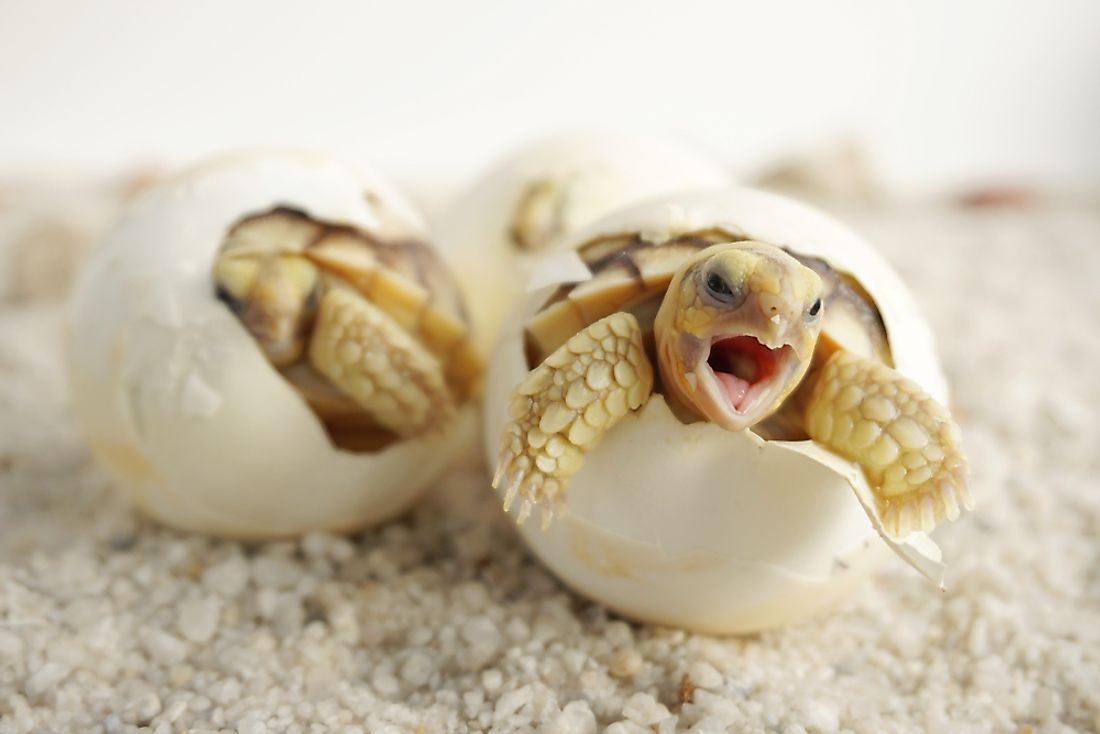What Are the Characteristics of Reptiles?

The term “reptile” is derived from a Latin word meaning “creeping animals.” These animals include snakes, lizards, crocodiles, caimans, alligators, turtles, geckos, and chameleons, with lizards and snakes species making up the majority of all reptiles. Reptiles are cold-blooded animals which means they are unable to regulate their own body temperature. The first reptiles evolved approximately 320 million years ago from the advanced four-limbed vertebrates known as reptiliomorph. These early reptiles became adapted to life on dry land. Reptiles have diverse ways of defending themselves from danger including biting, hissing, camouflaging, and avoidance. This article focuses on some of the most outstanding characteristics of reptiles.
6. Reptiles Are Oviparous (Egg Laying)
Most reptiles reproduce sexually while others are capable of reproducing asexually. The reproduction activities take place through the cloaca located at the base of the tail. Copulatory organs can be seen in most reptiles which are often stored inside their bodies. Male turtles and crocodiles have a penis while lizards and snakes have a pair of hemipenes. Other species like the tuatara do not have copulatory organs hence mating is through the pressing together of the cloaca. After successful copulation, the female reptile lays eggs which are covered with a shell. The eggshell protects and keeps the embryo from drying out and allows for the exchange of gasses. The egg contains chorion which aids in gaseous exchange, the albumen which is a reservoir for protein and water, and the amniotic fluid which protects embryo and aids in osmoregulation. Some reptiles incubate the eggs by laying on them while others bury them in the sand until they hatch.
5. Reptiles Are Cold-Blooded (Ectohtermic)
Most reptiles are cold-blooded vertebrates. They do not have the psychological means of regulating their body temperatures and have to depend on the external environment. Other species exhibit a mix of ectothermy, poikilothermy, and brandymetabolism. Reptiles often bask in the sun or hibernate during cold seasons to raise their body temperatures. When the sun is too hot, they will retreat to shady areas or inside the water to cool or lower their body temperatures. Because reptiles have unstable body temperature, their metabolism requires enzymes that are capable of maintaining efficiency over a range of temperatures. It is assumed that reptiles cannot produce enough energy required for long-distance chase like the warm-blooded animals. However, it remains unclear as to whether their cold-bloodedness is as a result of their ecology or not.
4. Reptiles Typically Have Four Legs
Reptiles have either four legs, or some like snakes, are descendants of four-limbed ancestors. In most snakes, all traces of legs including bones for the legs have disappeared. However, they still remain successful predators even without the legs. Snakes have three ways of moving on land; straight crawling, lateral undulating, and sidewinding. Although lizards have four limbs, most lizards have an alternating gait which limits their endurance. The tail of some lizards is prehensile and can assist them in climbing. Some reptiles like crocodiles have claws on their feet. These claws assist in movement and hunting.
3. Reptiles Breathe Through Lungs
Reptiles breathe through their lungs. Although turtles have permeable skin through which gaseous exchange takes place while some species increase the rate of gaseous exchange through the cloaca, the breathing process can only be completed through the lungs. Breathing through the lung is accomplished differently in different groups of reptiles. In lizards and snakes, the lungs are ventilated by axial musculature which is also used in locomotion. Because of these, most of the species are forced to hold their breath during intense activities. However, some lizards employ buccal pumping to aid in breathing. Crocodiles have muscular diaphragms with the muscles pulling the pubis back to free space for the lungs to expand. Some reptiles do not have secondary palates, thus, they have to hold their breath while swallowing. However, crocodiles have developed bony secondary palates which allow them to breathe underwater.
2. Reptiles Are Vertebrates
Reptiles exhibit similar characteristics of other vertebrates like mammals, birds, and some amphibians. They have backbones that house the spinal cords that run the length of their bodies. Reptiles also have chains of bony elements from the tail to the head. The bony endoskeleton consists of cranium or skull, appendages, and limb girdles. The endoskeleton protects the inner tissue and also aids in body movement. Skeletons differ from one species to another, with crocodiles having some of the largest body structures in this class.
1. Reptiles Have Scales or Scutes
One of the major distinguishing factors between reptiles and other animal classes is the presence of scutes or scales. The scales covering the body of reptiles are made of keratins and formed from the epidermis unlike fish scales which are formed from the dermis. The scales are either tubular or ossified but can also be modified elaborately like in snakes. The scales on lizards vary from tubular to plate-like and are composed of the thorny epidermis. The scales may also differ in form depending on their location on the lizard. Snakes are completely covered with scales of different sizes and shapes. The scales protect the body, helps in retaining the moisture, and aids in movement. They are also responsible for the body coloration and patterns. Crocodiles and turtles have scutes which do not form the overlapping structures like the snake scales. These scutes are formed from the deeper dermis and are often considered as dermal armor in reptiles.







